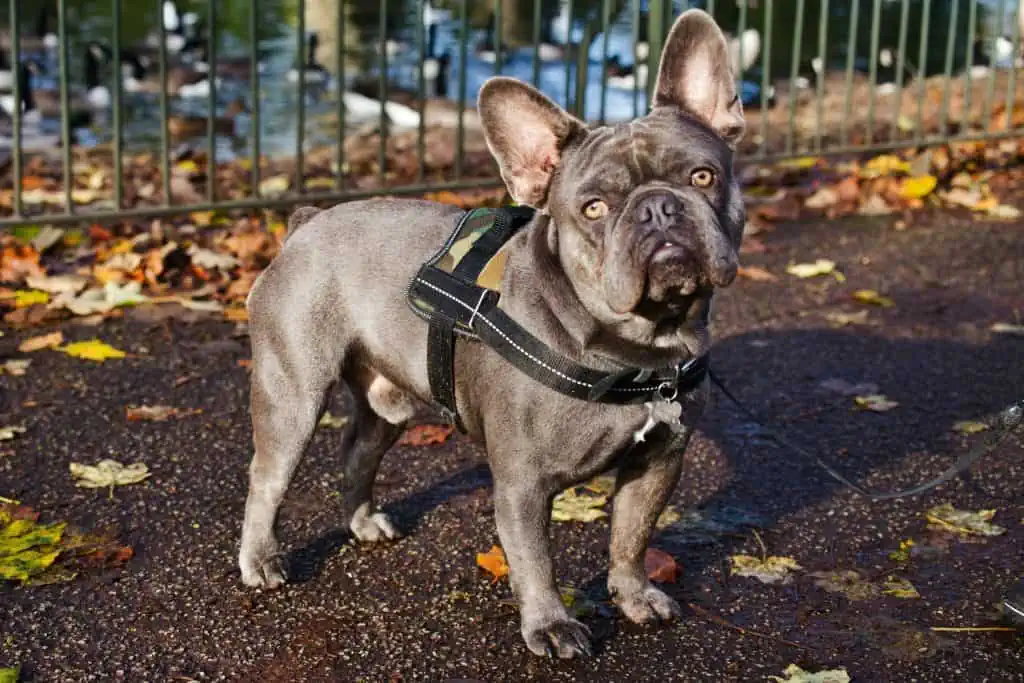French Bulldogs are some of the most popular dogs not only in the United States, but throughout the world.
The tiny Frenchie stands proud as number two on their list of America’s most beloved purebreds, placing just behind the Labrador Retriever but outshining other top dogs like Golden Retrievers, German Shepherds, and Poodles.
And while French Bulldogs are certainly turning heads, there’s a particular color variation that’s making even more of a scene. That’s right, folks – we’re talking about the Blue French Bulldog!
This cute canine has everything a Frenchie fan is sure to adore, from that squished face to that sassy personality.
With that said, there’s plenty you may not know about the Blue French Bulldog. So, before you decide if this is the right dog for you, take a look at our list of 12 things you should know.
Contents
1. The Blue French Bulldog Is A Rare Bulldog Indeed
Blue French Bulldogs are difficult to come by because they are so rare.
You may be able to count on your one hand how many times you’ve seen a Blue French Bulldog in the flesh, and that’s for good reason. This beautiful color of Frenchie is quite rare thanks to the unique genetics it takes to produce his coat color.
So, what is a true Blue French Bulldog? The Blue French Bulldog is generally smaller than his typical Frenchie counterparts, standing around 11 to 13 inches tall and weighing no more than 28 pounds.
And then there’s his signature blue coat, which may include white on the chest and paws. Other Blue French Bulldogs may be all blue, and though often born with blue eyes, Blue Frenchie dogs usually mature to have brown eyes. However, there are some instances where Blue French Bulldogs have maintained blue or green eyes into adulthood.
2. Blue French Bulldogs Are Small But…Well…Noisy
Though tiny, Blue French Bulldogs make a lot of noise with that nose and mouth of theirs.
How can something so small be so loud? Well, if you’re familiar with French Bulldogs, you may already be prepared for this fun fact about the Blue Frenchie.
The Blue French Bulldog is famous for his loud breathing, snoring, and snorting, and while many Frenchie fans find this an endearing quality, the sad truth is that these dogs are so loud because of a health condition known as Brachycephalic Airway syndrome.
This condition is caused by their flattened face and skull structure, which makes breathing difficult for these dogs. The difficulty breathing causes them to have to work harder, leading to loud wheezing, snorting, and snoring when they are sleeping.
There is no way to fix this condition, and it is common in all flat-faced breeds. Sadly, Brachycephalic Airway Syndrome not only makes it difficult for your Blue French Bulldog to get a good lungful of air, but it can also lead to heat sensitivity, a higher rate of heat stroke, and other complications.
3. The Blue French Bulldog Is Prone To A Unique Health Condition
Sadly, Blue Frenchies can be prone to more unique health issues than their counterparts.
All French Bulldogs have Brachycephalic Airway Syndrome, but not all French Bulldogs have Color Dilution Alopecia (CDA). Unfortunately, CDA is common in Blue French Bulldogs thanks to the same genetic trait that makes them so unique.
Color Dilution Alopecia is a condition caused by a recessive gene that is inherited by your dog’s parents. This condition can cause serious skin and hair problems for your Blue French Bulldog, including itching, scaly or flakey skin, hair thinning, and even hair loss.
While Color Dilution Alopecia cannot be cured, the good news is that it can be managed with proper care. This care could include medicated ointments, shampoos, rinses, and even oral treatments as prescribed by your veterinarian.
4. Blue French Bulldogs In General Also Have A Number Of Other Health Issues
Like all French Bulldogs, Blue French Bulldogs can also be prone to suffering from a number of other health problems.
Along with Brachycephalic Airway Syndrome and Color Dilution Alopecia, the Blue French Bulldog is prone to a number of other health conditions that a potential owner should be aware of.
With a lifespan of around 10 to 12 years, the Blue French Bulldog has been known to also suffer from digestive issues, ear infections, conjunctivitis, Skin Fold Dermatitis, Pyoderma, Upper Respiratory Tract Infections (URT), bone and joint issues, allergies, and food sensitivities.
Because these dogs do have such a long list of health issues, it’s important for a potential owner to prepare accordingly. If you are considering getting a Blue French Bulldog, it would be wise to invest in pet health insurance or to have savings put aside to help ensure you can keep your Blue French Bulldog as healthy as possible.
5. Exercise, Diet, and Proper Grooming Are Very Important For A Blue French Bulldog
Make sure you keep up with proper diet, grooming, and exercise to help maintain your Blue French Bulldog’s health.
Since health can be such a factor in your Blue French Bulldog’s quality of life, you’ll want to make sure you provide your dog with the healthiest of lifestyles.
This should include proper exercise each and every day. Though small and rather relaxed, the Blue French Bulldog will enjoy having a brisk walk or two each day along with free playtime either in a securely fenced yard or inside your home.
Exercise can help reduce bone and joint issues as your Blue Frenchie ages, and it can even help enhance his immune system while also keeping him mentally happy.
Diet plays another important role in your Blue French Bulldog’s health. Because French Bulldogs in general can be prone to digestive issues, allergies, and food sensitivities, we suggest a high quality dog food specified for small breed dogs that contains limited ingredients for dogs with sensitivities.
Dog foods containing real animal proteins like fish or lamb are likely going to be better than dog foods containing chicken or poultry, and you may want to opt for wet dog food over dry dog food to help your dog with digestion.
Last, be sure you keep up with proper grooming. This is especially important considering the Blue French Bulldog can be prone to so many skin issues. Invest in quality grooming tools, quality shampoos, and skin-fold cleaners, and consider visiting a professional groomer at least once every few weeks for routine ear cleanings and nail trimmings.
6. The Blue French Bulldog Was Bred For Companionship
These dogs are velcro dogs, which means they are not going to want to leave your side.
If you’re looking for your next best friend, you’ve found it in a Blue French Bulldog. These dogs were bred primarily for companionship, and as such they are happiest when they can be around their human family members.
The flip side to this is that the Blue French Bulldog is not the ideal dog for owners who are away often. They can be prone to suffering from separation anxiety and depression if left home alone too long, so keep this in mind when deciding if the Blue French Bulldog is right for you.
With that said, if you’re looking for a relaxed lap dog that will love nothing more than snuggling at your side while you lounge on the couch and read a book, then you and a Blue Frenchie were a match made in doggy heaven.
7. Blue French Bulldogs Are Not Eligible For Show
Although they are beautiful, Blue French Bulldogs are not eligible for show.
This is a fact that may surprise you considering how beautiful the Blue French Bulldog really is. And while Blue French Bulldogs may cost you as much as a quality show dog (more on that further down), the truth is that these pups are not always recognized by major breed clubs.
The reason is because the Blue French Bulldog is not considered to be a purebred French Bulldog or a mixed breed due to his unique coat color. The color calls into question whether or not the Blue French Bulldog is purebred and it also has an implication on the dog’s health, as we’ve already seen.
8. The Blue French Bulldog Is Not Actually French At All!
French Bulldogs actually originated in England.
In Spite of his name, the Blue French Bulldog does not actually hail from France. In fact, the French Bulldog was bred down from English Bulldogs originally bred for blood sports in England, shortly after bloodsports were outlawed.
They were mixed with French ratting dogs to help reduce their size before eventually making their way to France where they eventually acquired their name.
9. A Blue French Bulldog May Be More Relaxed Than Other Colors
The Blue French Bulldog is much more laid back than other colors.
Typical French Bulldogs are outgoing, adventurous, and somewhat mischievous. While the Blue French Bulldog can also be these things, this little dog tends to be more relaxed than his other colored counterparts.
This could be due to his somewhat smaller size, but it is likely more due to their incredible devotion to their owners. As we mentioned above, Blue French Bulldogs are companion dogs through and through, and they are much happier when they can be near their owners.
This means that if you want to get up and go for a walk, they’ll be happy to join you! But if you would prefer to lay back and relax by the fire, they’re ready to kick their paws up at your side.
10. Blue French Bulldogs Hardly Shed!
Thanks to their unique genetics, Blue French Bulldogs are not heavy shedders.
Although they are not considered hypoallergenic, Blue French Bulldogs do shed less than other French Bulldogs thanks to that fancy recessive gene we mentioned earlier in this article.
The gene that helps to dilute their coat color and make it brown also reduces the amount of loose fur they produce. On average, Blue French Bulldogs shed most twice a year during the shedding season in spring and fall.
So while they can still lead to allergies in those with sensitivities, they are less likely to leave loads of shed fur all over your clothing, furniture, and car.
11. Water Is Not Your Blue French Bulldog’s Friend
The Blue French Bulldog is much safer on land and away from water.
Well, water is not really any French Bulldog’s friend, if we’re being honest. The Blue French Bulldog’s flattened face makes him more susceptible to drowning, so it’s essential to never leave your Blue Frenchie unaccompanied near open water like a pool, pond, or lake.
If you do want to take your Blue French Bulldog near water, or if you’re a family or person who enjoys water sports, be sure to invest in a canine water vest for your dog. Even then, do not leave your French Bulldog unattended, as these dogs are not swimming dogs at all.
12. The Blue French Bulldog Is A Pricy Pup
Depending on the source you go through, French Bulldogs can cost you thousands.
If you want to get your hands on a Blue French Bulldog, be prepared to spend a pretty penny. Because these dogs are so rare, they are difficult to come by, leading to an inflation in cost.
On average, Blue French Bulldogs can cost between $1,000 and $4,000, though some can run you even more depending on the quality of their parent breeds and the breeder in question.
We should also note here that if you are looking to get a Blue French Bulldog, remember to only go through reputable sources. This is important for anyone looking for any dog, but especially if you are looking for dogs who can be especially prone to unique health issues like the Blue Frenchie.
And although Blue French Bulldogs can be expensive, it’s best to avoid trying to cut costs by going through irresponsible sources like online sellers or backyard breeders.
Instead, choose breeders who are licensed and have experience with breeding French Bulldogs. You can also request health certificates proving your puppy has been screened and cleared of any serious health issues.
Is The Blue French Bulldog Right For You?
The Blue French Bulldog is certainly built for companionship, but that doesn’t mean he’s right for everyone.
The Blue French Bulldog is a family-friendly color variation of the traditional French Bulldog with a few unique twists. He is somewhat smaller, a bit more laid back, and may even be more affectionate than typical French Bulldogs of other colors.
While all of these traits are wonderful for anyone looking for a devoted family companion, remember also that the Blue French Bulldog can be more prone to unique health issues than other French Bulldogs.
Furthermore, the Blue French Bulldog is likely going to cost more than traditionally colored French Bulldogs while also not being eligible for show.
Still, in the right household and with the right family or owner, the Blue French Bulldog is sure to make a winning furry friend.
Is this the right dog for you? Tell us what you think in the comment section below!


Jen Jones is a professional dog trainer and behavior specialist with more than 25 years of experience. As the founder of ‘Your Dog Advisor’ and the ‘Canine Connection’ rehabilitation center, she applies a holistic, empathetic approach, aiming to address root causes rather than merely treating symptoms.
Well known for her intuitive and compassionate approach, Jen adopts scientifically-proven, reward-based methods, encouraging positive reinforcement over punishment. Jen specializes in obedience training, behavior modification, and puppy socialization. Her innovative methods, particularly in addressing anxiety and aggression issues, have been widely recognized. Jen has worked with many of the world’s leading dog behaviorists and in her free time volunteers with local animal shelters and rescue groups.













